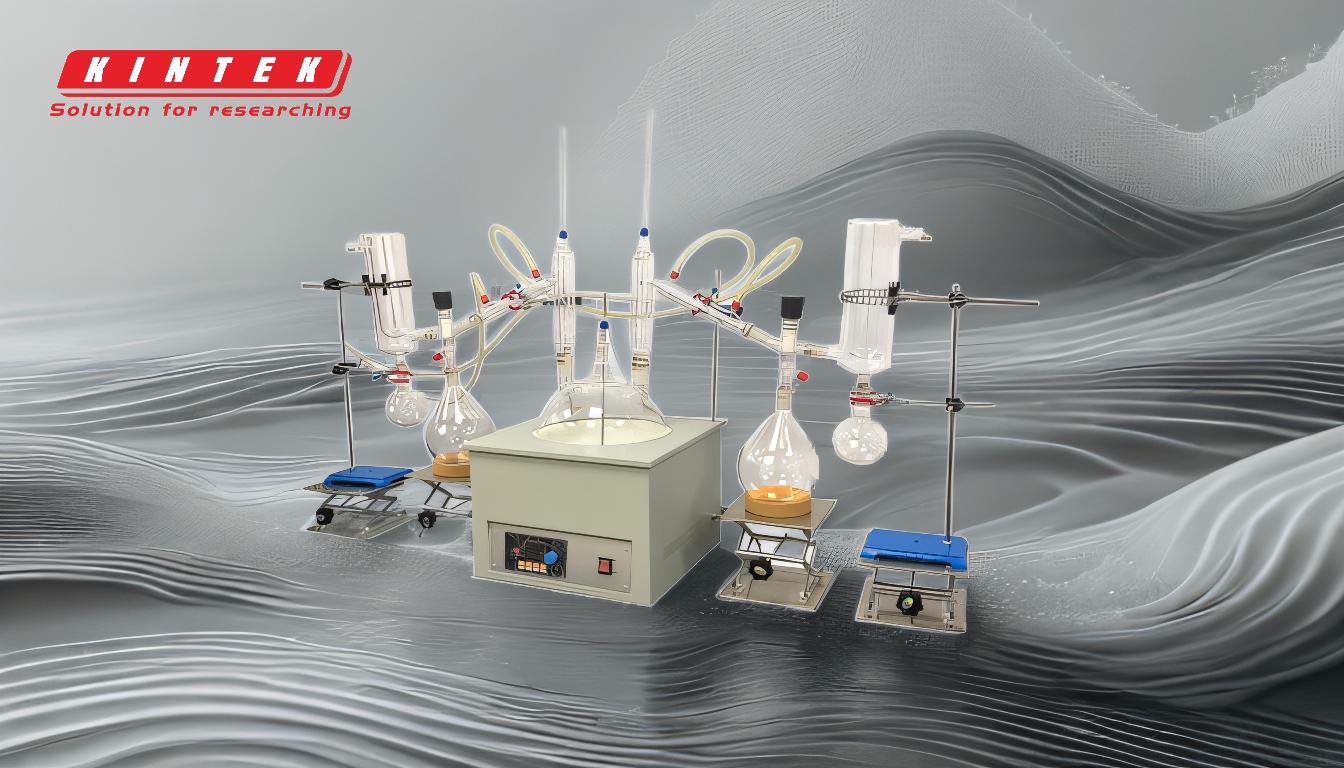Short path distillation is a specialized technique used for the purification and separation of compounds, particularly those that are heat-sensitive or have high boiling points. It operates under high vacuum conditions, which significantly lowers the boiling points of substances, allowing for efficient separation without thermal degradation. The process involves heating a mixture in a boiling flask, evaporating the components, and then condensing them in a nearby condenser. The condensed fractions are collected in separate flasks based on their molecular weights. This method is highly effective for refining essential oils, cannabinoids, and other sensitive compounds.
Key Points Explained:

-
Principle of Short Path Distillation:
- Lowering Boiling Points: The process relies on reducing atmospheric pressure inside the distillation system, which lowers the boiling points of the substances being distilled. This is crucial for distilling heat-sensitive compounds without causing degradation.
- Heat and Vacuum: The material is heated in a boiling flask, and the vacuum pump creates a high vacuum environment. This combination facilitates the evaporation of compounds at lower temperatures.
-
Key Components of the System:
- Boiling Flask: The starting point where the material is placed and heated.
- Short Path Head: Connects the boiling flask to the condenser, ensuring a short distance for vapor travel.
- Condenser: Cools the vapors, causing them to condense back into liquid form.
- Receiving Cow and Flasks: Collect the condensed fractions based on their molecular weights.
- Vacuum Pump: Creates the necessary vacuum to lower boiling points.
- Chiller: Maintains the condenser temperature to ensure efficient condensation.
- Cold Trap: Captures any vapors that escape the condenser, protecting the vacuum system.
-
Process Steps:
- Heating and Evaporation: The material is heated in the boiling flask, and the vacuum lowers the boiling points, causing the compounds to evaporate.
- Vapor Travel: The vapors travel a short distance to the condenser, minimizing the risk of thermal degradation.
- Condensation and Collection: The vapors are cooled in the condenser, condensed into liquid form, and collected in separate flasks based on their molecular weights.
-
Advantages of Short Path Distillation:
- Efficiency: The short distance between the boiling flask and condenser minimizes distillate loss and ensures efficient separation.
- Purity: The process allows for the collection of highly pure fractions, making it ideal for refining sensitive compounds.
- Versatility: Suitable for a wide range of applications, including essential oils, cannabinoids, and other heat-sensitive materials.
-
Applications:
- Essential Oils: Used to refine and purify essential oils, ensuring high purity and quality.
- Cannabinoids: Effective in separating and purifying cannabinoids from cannabis extracts.
- Pharmaceuticals: Utilized in the purification of heat-sensitive pharmaceutical compounds.
-
Equipment and Materials:
- Glassware: Thick glass components are used for protection and durability.
- Heating Mantle: Provides controlled heating to the boiling flask.
- Metal and Graphite Components: Includes wiper elements and rollers for efficient material handling.
- PTFE Components: Spring-loaded PTFE parts ensure a tight seal and smooth operation.
-
Operational Considerations:
- Temperature Control: Precise control of heating and cooling temperatures is crucial for effective distillation.
- Vacuum Depth: The depth of the vacuum must be carefully managed to achieve the desired boiling point reduction.
- Material Handling: Proper handling and loading of the material into the boiling flask are essential for optimal results.
In summary, short path distillation is a highly effective technique for the purification and separation of heat-sensitive compounds. By operating under high vacuum conditions, it allows for the efficient distillation of substances with high boiling points, ensuring high purity and minimal thermal degradation. The key components and precise control of temperature and vacuum depth are critical for the success of this process.
Summary Table:
| Key Aspect | Description |
|---|---|
| Principle | Operates under high vacuum to lower boiling points, preventing thermal degradation. |
| Key Components | Boiling flask, short path head, condenser, vacuum pump, chiller, and cold trap. |
| Process Steps | Heating, evaporation, short vapor travel, condensation, and fraction collection. |
| Advantages | High efficiency, purity, and versatility for heat-sensitive compounds. |
| Applications | Essential oils, cannabinoids, and pharmaceuticals. |
| Equipment | Glassware, heating mantle, metal/graphite components, and PTFE seals. |
| Operational Considerations | Precise temperature control, vacuum depth, and material handling are critical. |
Discover how short path distillation can enhance your purification process—contact our experts today!













